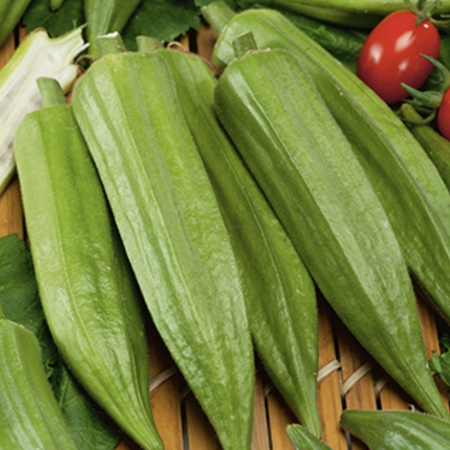Star of David, Organic Okra Seed
Key Attributes
Key Attributes
Product Details
Weight
.008Plant Height
8-10'Botanical Name
Abelmoschus esculentusSeed Type
SeedSeeds Per Gram
18Seeds Per Pound
8,000Packet
50 SeedsSow Depth
1/2"Seeds Per Ounce
500Breed
Open-pollinatedSun
Full SunLife Cycle
AnnualCategories
OkraGermination
11,12,13,14,7,8,9,10Days To Maturity (# Days)
60Organic
OrganicHeirloom
HeirloomSeeds Per Acre
4-6 lbsComponents
Growing Instructions
![]() Learning Download: How to Grow Okra
Learning Download: How to Grow Okra
Okra may not be a common vegetable found in a garden, but it makes for good canning and pickling. It also can be used in stews. Okra is a warm-weather plant often grown in southern climates. It has a taste similar to eggplant.
Before Planting: Soak the okra in water for 12 to 18 hours prior to planting to soften the outer shell of the seed. Plant okra in the spring or early summer after the danger of frost has passed. In northern climates, plant okra indoors four to six weeks prior to the last frost date. Since okra can reach 6 feet tall, plant it in an area of the garden where its shade won’t harm other plants’ growth.
Planting: For direct seeding, after frost danger, sow 2″ apart, 1/2″ deep when soil is warm – at least 70°F. Thin to 12-18″ apart. For transplanting, sow in 2″ pots, 2-3 seeds per pot, 1/4″ deep and thin to 1 plant when 2″ high. Start 4-5 weeks ahead of transplanting out after frost danger when soil is warm. Keep soil mix temp. 80-90°F for best germination rate. Transplant 12-18″ apart in rows 3′ apart. Do not disturb roots.
Watering: Water 1 inch per week.
Fertilizer: Prior to planting, mix a 10-10-10 fertilizer in with the soil. Once okra reaches 6 inches tall, give a side-dressing of fertilizer. Side-dress again two to three weeks later. Reapply the fertilizer every four to six weeks throughout its growing season.
Days to Maturity: Okra is ready two months after planting. Pods should be approximately 3 inches long when harvested. (See each variety for days to maturity)
Harvesting: Harvest promptly by clipping pods at 3-4″ long to keep plants productive. Oversized pods become tough and decrease overall yield of plant.
Tips: Wear gloves when harvesting, because okra has spines.
AVG. Direct Seeding Rate: 1 oz./78′, 13 oz./1,000′, 12 lb./acre at 6 seeds/ft. in rows 36″ apart.
Shipping Schedule
Our Seed Promise
 "Agriculture and seeds" provide the basis upon which our lives depend. We must protect this foundation as a safe and genetically stable source for future generations. For the benefit of all farmers, gardeners and consumers who want an alternative, we pledge that we do not knowingly buy or sell genetically engineered seeds or plants.
"Agriculture and seeds" provide the basis upon which our lives depend. We must protect this foundation as a safe and genetically stable source for future generations. For the benefit of all farmers, gardeners and consumers who want an alternative, we pledge that we do not knowingly buy or sell genetically engineered seeds or plants.
The mechanical transfer of genetic material outside of natural reproductive methods and between genera, families or kingdoms, poses great biological risks as well as economic, political, and cultural threats. We feel that genetically engineered varieties have been insufficiently tested prior to public release. More research and testing is necessary to further assess the potential risks of genetically engineered seeds. Further, we wish to support agricultural progress that leads to healthier soils, to genetically diverse agricultural ecosystems, and ultimately to healthy people and communities.
To learn more about the "Safe Seed Pledge" please visit www.councilforresponsiblegenetics.org.

